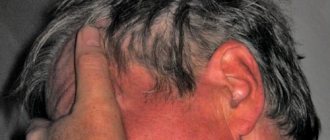There is no consensus on what neuroses are. The dominant point of view in medicine today is based on the causes (etiology) that cause neurosis. This point of view on diseases of psychogenic etiology is appropriate and has practical importance when choosing a strategy for the treatment of neuroses and their prevention.
Neuroses should be understood as “...functional disorders of nervous activity caused by mental trauma, in other words, by stimuli, the effect of which is determined not by their physical parameters, but by their informational value.” Information that becomes the cause of the development of neuroses can be transmitted orally or in writing, and can also be of a “visual” nature (for example, a person’s participation or third-party observation of any traumatic events that cause internal conflict).
The most common causes of the development of neuroses include:
- love failures;
- family conflicts;
- loss (death) of loved ones;
- troubles at work, dismissal;
- bringing to punishment for a crime;
- threat to life, health, well-being;
- collapse of long-term plans.
However, it is information transmitted through speech that is the most common cause of the development of neuroses. Such information can have a one-time, but powerful blow to the human psyche, or deliver mild traumatic experiences over a long distance, contributing to the accumulation of internal tension, with the increasing manifestation of symptoms and signs of neuroses.
General symptoms and signs of neuroses
Based on the variety of life situations that cause internal conflict, the symptoms and signs of neuroses are often quite complex to identify variations in unusual reactions and behavior. In other words, very often a person does not correlate such reactions and behavior with the presence of a neurotic disease, considering them to be personality traits.
Neuroses can cause the emergence and development of somatic pathology. This is caused by a reaction to a stress factor, which provokes various disorders of the autonomic nervous system, which is responsible for the functioning of internal organs, glands, blood and lymphatic vessels.
As a rule, the personality of a neurotic combines variations of common characteristics characteristic of most cases:
- dependence on the assessment of others;
- illogical aggressiveness;
- hostile ambition;
- sexual compensation for low self-esteem;
- expression of pathologically inflated self-esteem;
- workaholism or, on the contrary, an infantile attitude to work;
- suppression of feelings of inferiority.
It is important to understand that the above symptoms and signs of neuroses reveal themselves in the dynamics of life. For example, in contrast to a non-neurotic personality, a person with neurosis will justify his illogical behavior, find reasons for fears, helplessness and passivity when it is necessary to make decisions, as in the case of aggression, hatred, and socially unacceptable actions on his part.
Rice. 1. Types and causes of neuroses.
Symptoms of neuroses in children and adolescents
According to some authors, mainly from a psychoanalytic direction, the prerequisites for the development of neuroses are unresolved internal conflicts in childhood and adolescence. As a rule, symptoms of neuroses in children and adolescents can manifest themselves against the background of difficult situations for a fragile psyche, addictive behavior of parents, which create the basis for the development of a full-fledged neurotic disorder, for example:
- strict upbringing, often with violence;
- family conflicts, divorce, alcoholism of one or both parents;
- development of feelings of insecurity, inferiority, helplessness.
At the same time, the symptoms of neuroses in children and adolescents can have either a pronounced character for others or be hidden behind an outwardly calm (depressed) state, masked as the “indifferent” character of the child. Such symptoms of neuroses include excessive tearfulness, touchiness, hysterical reactions, and manifestations of excessive and inappropriate aggression. Signs of neuroses that are more difficult to recognize as a psychopathological state are apathy, isolation, increased fatigue, and sleep disturbances.
Rice. 2. Neuroses and other diseases.
Symptoms and signs of neuroses in men
It is generally accepted that neurotic diseases are characteristic of women. In practice, neuroses occur equally in both women and men. The same can be said about the symptoms of neuroses, which are associated in the public consciousness with “unbalanced” reactions of women to stress - they are not alien to men.
The characteristic symptoms and signs of neuroses in men include the following:
- apathy;
- lack of initiative;
- fatigue;
- decreased speed of thinking;
- forgetfulness;
- inadequate (“violent”) reactions to situations;
- mood swings.
Due to the peculiarities of male upbringing, among the symptoms and signs of neuroses in men, in rare cases, there may be uncontrollable tearfulness, a tendency to public self-accusation or other attacks of a hysterical nature. In other cases, men simply find the strength to overcome the signs of “female” type neuroses or do not demonstrate them in front of other people.
Rice. 3. Neuroses among mental disorders.
Symptoms and signs of neuroses in women
Symptoms and signs of neuroses in women differ from those of the opposite sex due to the physiological characteristics of the body and the characteristics of upbringing. If in men, for example, reversible impotence is often encountered, then in women, amenorrhea is a symptom of neuroses similar in type to the “nature of sex”.
Among the symptoms and signs of neuroses in women, the most striking are:
- anxiety;
- irritability;
- expressiveness of behavior;
- refusal to eat;
- excessive tearfulness;
- mood swings.
More often in women than in male patients, among the symptoms of neuroses are complaints of insomnia, dreams of a frightening nature (up to the appearance of sleep paralysis) or difficulties in falling asleep. However, in each specific case, the complex of symptoms of neuroses will depend on the case and individual characteristics of the individual.
Autonomic symptoms and nostalgia for neuroses
Summary
The article contains data on the connection of autonomic symptoms, stress and mental disorders with the activity of various types of neurons. It is shown why patients with vegetative symptoms turn not to psychiatrists, but to internists. Currently, it is difficult for internists to treat vegetative symptoms, which are classified as mental disorders. Effective tranquilizers require a special prescription form, and antidepressants require consultation with a psychiatrist. Many internists remember the time of neuroses, when they could treat vegetative symptoms themselves. Perhaps it is time to allow internists to diagnose and treat mental disorders with autonomic symptoms. Pending reforms, tofisopam (Grandaxin) can be used to treat autonomic symptoms.
Summary
The article contains data on the connection of autonomic symptoms, stress and mental disorders with the activity of different neurons. It is shown why patients with vegetative symptoms do not apply to psychiatrists, but to internists. Currently it is difficult for internists to treat vegetative symptoms. They are referred to as mental disorders. Effective tranquilizers require a special form of recipes. Consultation with psychiatrists is required to prescribe antidepressants. Many internists remember the time of neurosis, when they themselves could treat the vegetative symptoms. Perhaps it is time to allow internists to diagnose and treat mental disorders with vegetative symptoms. Pending reforms for the treatment of vegetative symptoms, you can use tofizopam (Grandaxin).
Severe vegetative symptoms1 have long been considered as manifestations of neuroses (hypochondriacal, hysterical, anxious, etc.) (1). This diagnosis was quite acceptable to the patients. It indicated a neural origin of their symptoms and was not associated with mental disorders (diseases such as schizophrenia). In other words, the diagnosis was closer not to “psychiatry”, but to “neurology” (neuropathology) - a medical specialty whose representatives traditionally treated patients in regular clinics or clinical hospitals. As a result, patients could seek help in their “familiar” healthcare institutions, avoiding contact with psychiatric services.
In addition, if a patient was frightened by even such a diagnosis as “neurosis,” he could easily be “ennobled.” For vegetative symptoms, almost all therapeutic specialties had their own terms - syndromes (2):
- hyperventilation (pulmonology),
- vegetative dystonia (neurology),
- neurocirculatory dystonia and da Costa (cardiology)
- irritable bowel (gastroenterology),
- psychogenic pain in the head, neck, back (neurology), etc.
This situation suited everyone for a long time. To the point that “neuroses” began to disappear from domestic psychiatry, as patients with vegetative symptoms increasingly sought help from psychiatric institutions. The very admission of such a patient to a psychiatric hospital was often considered as a sign of the extreme severity of the condition and the inability to remain within the framework of “conventional” medicine. Based on this, the condition of such a patient was often qualified not as “neurosis”, but as “schizophrenia,” albeit poorly progressive or sluggish (3-4).
The current situation began to change after the complete disappearance of “neuroses” from the International Classification of Diseases, 10th revision (ICD-10) (2). Autonomic symptoms, according to the new classification, have become a diagnostic sign of other mental disorders. All of them were included in the heading “neurotic, stress-related and somatoform disorders” (NSSD). These diagnoses were new and could not cause unpleasant associations for anyone. However, their names (for example, panic disorder, social phobias, agorophobia, etc.) were already difficult to associate with “nerves.” On the contrary, they directly indicated that the patient suffered from a mental disorder.
At the same time, the “therapeutic” synonyms for neuroses listed above began to be viewed as outdated and incorrect. Deprived of “convenient” and “euphonious” diagnoses, patients with vegetative symptoms became “strangers” to clinics and clinical hospitals, although they continued to seek help there. Patients of the NSSSR could not “find a new home” in domestic psychiatry. After all, “new” diagnoses, similar to previous “neuroses,” are established extremely rarely (5).
At the same time, it became more difficult for physicians of therapeutic specialties to treat vegetative symptoms with the help of psychotropic drugs in clinics and clinical hospitals. During the times of “neuroses” and their synonyms, tranquilizers could be freely prescribed. Their “calming” name was consistent with the ideas of doctors and patients about the “nervous” origin of vegetative symptoms. This practice has not encountered any opposition from health care organizers. However, then the main tranquilizers, called benzodiazepines after the chemical structure of their molecules, began to be blamed for the frequent formation of drug dependence (6). In Russia, unlike other countries of the world, these drugs were on the list of drugs subject to subject-quantitative registration (7). For a long time, most benzodiazepines have to be prescribed on a special prescription form, and this has affected the frequency of prescriptions. Benzodiazepines are prescribed less and less outside of psychiatry.
The situation could be saved by antidepressants, which are often used abroad to treat NSSSR, the direct heirs of “neuroses” (8). However, this did not happen in our country for several reasons. Thus, in the instructions for antidepressants, their indications are formulated in accordance with ICD-10 (9). Meanwhile, it was already noted above that in this classification, vegetative symptoms are considered as manifestations of mental disorders. As a result, each prescription of antidepressants turns out to be tantamount to establishing a “psychiatric” diagnosis, indicating that the patient has a mental disorder.
In addition, many domestic health experts have long argued that any psychotropic drugs can only be prescribed by a psychiatrist (10). As a result, treatment of autonomic symptoms required consultation with this specialist. But this had to be agreed upon with the patient in advance. He had to explain why he needed a consultation with a psychiatrist and the prescription of an antidepressant for vegetative symptoms. And this despite the fact that the very name of such drugs indicates that they should be used for depression - a fairly severe mental disorder that has its own diagnostic criteria.
Recommendations for the use of certain antipsychotics have added further confusion to the situation (11). Here, quite logical questions could be asked not only by patients, but also by doctors of therapeutic specialties who identified vegetative symptoms. For example, why should “neuroses” (even former ones) be treated in the same way as psychoses? How to explain to patients that medications used for schizophrenia help their condition? How to combine antipsychotics with patient monitoring in a clinic?
The sharp reduction in the arsenal of drugs aimed at treating vegetative symptoms observed outside psychiatry contributed to a kind of idealization of bygone “neuroses.” Doctors of therapeutic specialties recalled with genuine warmth that in the past they themselves could provide assistance to such patients, at least with the help of benzodiazepine tranquilizers. However, lost diagnoses cannot be returned. And in the new International Classification of Diseases, 11th revision (ICD-11), “neuroses” are again absent (12). Perhaps the time has come to allow internal medicine physicians to independently diagnose and treat numerous mental disorders that include autonomic symptoms.
However, such a prospect still seems too vague. To implement it, it is necessary to resolve many issues related to the creation of national recommendations, development and implementation of relevant orders. It is necessary to assess how well the presented approach will comply with the existing legislative framework, for example, the law on mental health care (13), etc.
It is much easier to find and use the still available opportunities for the treatment of vegetative symptoms in clinics and clinical hospitals. First of all, this possibility is associated with the use of two benzodiazepine tranquilizers: bromodihydrochlorophenylbenzodiazepine (Phenazepam) and tofisopam (Grandaxin). Both drugs are prescribed on “regular” prescriptions, although the first of them has the ability to cause drug dependence when taken long-term in large doses (more than 4 mg/day) (14). Accordingly, the prescription of bromodihydrochlorophenylbenzodiazepine and tofisopam (15) is not associated with subject-quantitative accounting and should not cause any particular difficulties for physicians of therapeutic specialties. In addition, both drugs retained the same formulations of indications, allowing them to be prescribed for autonomic symptoms (autonomic dysfunction, autonomic lability, autonomic disorders, cardialgia). As a result, the reasons for prescribing bromodihydrochlorophenylbenzodiazepine (Phenazepam) and tofisopam (Grandaxin) should be quite clear to patients.
When prescribing, you need to take into account the severity of side effects and various restrictions when taking the drugs in question. They are presented in table. 1.
Table 1. Comparison of bromodihydrochlorophenylbenzodiazepine (Phenazepam) and tofisopam (Grandaxin) in terms of tolerability (14,15).
| Phenazepam | Grandaxin | |
| Side effects from the central nervous system and peripheral nervous system | - at the beginning of treatment (especially in elderly patients) - drowsiness, fatigue, dizziness, decreased ability to concentrate, ataxia, disorientation, gait instability, slowed mental and motor reactions, confusion; - rarely - headache, euphoria, depression, tremor, memory loss, impaired coordination of movements (especially at high doses), depressed mood, dystonic extrapyramidal reactions (uncontrolled movements, including the pelvis), asthenia, muscle weakness, dysarthria, epileptic seizures (in patients with epilepsy); - extremely rarely - paradoxical reactions (aggressive outbursts, psychomotor agitation, fear, suicidal tendencies, muscle spasms, hallucinations, agitation, irritability, anxiety, insomnia). | - headache, insomnia, increased irritability, and agitation may occur. - sometimes there is confusion, and convulsive seizures may occur in patients with epilepsy. |
| Impact on the ability to drive vehicles and operate machinery | During the treatment period, care must be taken when driving vehicles and engaging in other potentially hazardous activities that require increased concentration and speed of psychomotor reactions. | Grandaxin does not have a significant effect on attention and the ability to concentrate |
Bromodihydrochlorophenylbenzodiazepine (Phenazepam) is less well tolerated. When using it, you have to observe certain precautions related to driving vehicles and engaging in other potentially hazardous activities that require increased concentration and speed of psychomotor reactions. Therefore, for the treatment of vegetative symptoms in clinics and clinical hospitals, it is best for physicians of therapeutic specialties to use tofisopam.
But is it possible to treat vegetative symptoms with tofizopam “as before”, without focusing the patient’s attention on the fact that he has a mental disorder? The answer to this question lies in the data on the mechanisms of their formation. It is believed that the symptoms of NSSSR resemble changes that occur in the human or animal body during a normal (adaptive) reaction to stress. This response is formed with the participation of different neuronal systems (16). But two of them, GABAergic2 (GA) and serotonin (S), appear to be of decisive importance. The role of the first of them under normal conditions is to ensure rapid inhibition of any neurons (dopamine - D, norepinephrine - N, acetylcholine - A, histamine - GI, glutamate - GL, etc.). The activity of the second is rather associated with the selective inhibition of those neurons that exhibit increased activity and stand out from the general “symphony” of the vital activity of the nervous system (17).
Under the influence of stress, the activity of the GA and C systems decreases (Table 2).
Table 2. Mechanisms of formation of various manifestations of stress and NSSSR (16,17).
| neuronal activity | manifestations | |
| stress | NSSSR | |
| ↓GA,S + ↑D,N,A,GI,GL | anxiety | anxiety, phobias associated with a wide range of situations |
| fading | stupor, chronic feeling of “numbness” and emotional dullness, “stupefaction” | |
| undirected movements | agitation, psychomotor agitation | |
| flight or fight | avoidant or aggressive behavior | |
| ↓GA,S + ↑D,N | activation of thinking | fear of death, loss of self-control, or madness |
| ↓GA,C + ↑A | memory activation | intrusive memories, dreams or nightmares |
| ↓GA,S + ↑GI | increased level of wakefulness | sleep disorders (insomnia) |
| ↓HA,S + ↑H | increased blood pressure, heart rate, respiratory rate | panic attacks: 1) cardiac with palpitations, pain in the heart, pulsation of blood vessels, dizziness; 2) hyperventilation with rapid breathing, shortness of breath, feeling of lack of air, panic attacks |
| ↓GA,S + ↑GI,D,A | increased secretion of gastric juice, increased peristalsis of the gastrointestinal tract | epigastric discomfort, nausea, retching or defecation |
| ↓GA,S + ↑GL,N | increased muscle tone | motor tension with fussiness, tension headaches, tremors, inability to relax |
At the same time, a variety of neurons are disinhibited. Their rapid and simultaneous activation is accompanied by the development of anxiety. In addition, any purposeful activity is blocked. So, for a short time, a victim of stress may freeze and begin to rush around senselessly. But then the decline in the activity of some systems (↓GA, S) and the disinhibition of others (↑D, N, A, GI, GL) begins to work to overcome the stressful situation. The victim of stress may try to escape or fight. This is also facilitated by an increase in the activity of GI neurons, which are responsible for the level of wakefulness. Increasing the “tone” of D-, N-, and A-neurons, which are “responsible” for abstract thinking, the speed of thought processes and memory (respectively), allows you to more intensively and quickly think about the degree and nature of the threat, drawing on accumulated life experience for this.
Adaptation to stress is also achieved by changing the state of the autonomic nervous system, which regulates the functions of muscles and internal organs. For example, the H-system increases blood pressure (BP), the number of heart contractions (HR) and their strength, as well as the number (number) of respiratory movements (RR). Accordingly, an increase in the activity of H-neurons leads to an increase in blood pressure, heart rate and respiratory rate. The GL and H systems control the tone of the striated muscles, and with additional activation of these nerve cells, the muscles contract faster and more intensely. GI neurons influence the level of gastric juice secretion. As a result, when the activity of these neurons increases, the digestion process in the stomach accelerates. The functions of the D- and A-systems include the control of intestinal motility. Accordingly, high activity of D- and A-neurons accelerates the process of passage of food through the gastrointestinal tract.
The adaptive significance of the described “vegetative” processes is quite clear. An organism exposed to stress prepares for active actions (for example, flight or fight), which will require the mobilization of additional forces. In this situation, it is necessary to increase the flow of oxygen to various organs, including muscles (H-neurons). It is necessary to speed up the digestion of food and/or quickly empty the intestines (GI-, A-, D-neurons) in order to relieve the body experiencing stress from the “extra” load.
Manifestations of NSSSR seem to continue the symptoms of a normal reaction to stress, but there are also differences. For example, the activity of neurons during an ordinary reaction to stress changes only in connection with a real traumatic situation. Moreover, such changes are limited in time. As stress is managed, the normal functioning of these systems is gradually restored3. Meanwhile, the relationship between a stressful situation and the development of NSSSD is characteristic of only three disorders (acute stress reaction, post-traumatic stress disorder and adjustment disorder (2)). All other NSSSRs occur spontaneously or in situations that are not dangerous (2). In this case, disturbances in neuronal activity can last for quite a long time. The so-called undulating course with periods of improvement and deterioration of the condition.
However, perhaps it is the similarity of NSSSR with manifestations of normal stress that makes patients doubt that their complaints belong to a mental disorder, especially if they are bothered by autonomic symptoms associated with changes in muscle tone, blood pressure levels, heart rate, respiratory rate, gastrointestinal motility tract, etc. Therefore, patients are reluctant to agree to a consultation with a psychiatrist and prefer to seek help from doctors of therapeutic specialties. If doctors prescribe tofisopam (Grandaxin) to patients, they will have the right to count on effective treatment not only of vegetative symptoms, but also of other (“mental”) manifestations of NSSSR. This drug, like many other benzodiazepine tranquilizers, increases the activity of the GA system due to its effect on the so-called. GABAA receptors (16). And since the decrease in the “tone” of this system (along with the serotonin system) plays a key role in the pathogenesis of NSSSR, tofisopam will act on all their symptoms.
As for the advantages in tolerability of the drug in comparison with other benzodiazepine tranquilizers (for example, bromodihydrochlorophenylbenzodiazepine - Phenazepam), this is explained by the drug’s effect on a limited number of GABAA receptors located in the basal structures of the brain (18). In addition, tofisopam has its own binding site on these receptors, which is different from those used by “conventional” benzodiazepines (19). As a result, the drug does not cause excessive inhibition of the central nervous system, which is especially important when treating patients in therapeutic practice (15).
Of course, a complete arsenal of psychotropic drugs for the treatment of vegetative symptoms cannot consist only of tofisopam. The presented data on the mechanisms of formation of these disorders make it possible to understand why in this situation some benzodiazepine tranquilizers, antidepressants and antipsychotics are successfully used abroad. The former activate the main inhibitory GA system, and the latter (with the exception of agomelatine) act in a similar way on the C system. As for antipsychotics, many of them are capable of inhibiting D-, N-, GI-, and A-neurons. However, the question of using all these drugs in the treatment of vegetative symptoms in therapeutic practice is seriously complicated for the reasons stated at the beginning of the article.
Bibliography.
- List of ICD-9 codes: Section V. https://ru.wikipedia.org/wiki/List_ICD-9_codes:_Section_V
- Mental disorders and behavioral disorders (F00 - F99) Class V ICD-10, adapted for use in the Russian Federation Moscow 1998 https://psychiatr.ru/download/1320?view=1&name=ICD-10+adapted+for+RF+ 1998.pdf
- Smulevich A. B. Low-progressive schizophrenia and borderline states, M., 1987.
- Smulevich A. B. Special forms of schizophrenia. Sluggish schizophrenia. In the book. Endogenous mental illnesses. Ed. A.S. Tiganova. https://ncpz.ru/lib/54/book/29/chapter/9
- Kalinina E.V. Characteristics of patients diagnosed with a mental disorder for the first time in their lives in the Chuvash Republic (clinical, epidemiological and socio-demographic aspects). Diss. ...cand. honey. Sci. Moscow, 2006.
- Long-term use of benzodiazepines: Definitions, prevalence and usage patterns—a systematic review of register-based studies. Kurko TA, Saastamoinen LK, Tähkäpää S, Tuulio-Henriksson A, Taiminen T, Tiihonen J, Airaksinen MS, Hietala J. Eur Psychiatry. 2015 Nov;30(8):1037-47. doi: 10.1016/j.eurpsy.2015.09.003.
- List of Medicines subject to PCU. https://www.ecopharmacia.ru/publ/organizacija_i_ehkonomika_farmacii/uchet_i_otchetnost_apteki/novyj_perechen_ predmetno_kolichestvennogo_ucheta_perechen_pku/11-1-0-852
- Drobizhev M.Yu., Kikta S.V., Machilskaya O.V. Cardiac psychiatry. Translation problems. Cardiovascular therapy and prevention. 2016; 15 (4): 88-98.
- Recommendations of the World Federation of Societies of Biological Psychiatry (WFSBP) on the pharmacotherapy of anxiety, obsessive-compulsive and post-traumatic disorders. https://psychiatr.ru/download/2041?view=1&name=stpr_2011_03.pdf
- Krasnov V.N., Bobrov A.E., Dovzhenko T.V., Starostina E.G., Kuznetsova M.V. Problems, prerequisites and necessary measures to improve the interaction of psychiatric (psychotherapeutic) services with primary care doctors. Mental health. 2011; 63 (8): 3-12.
- Teraligen - official instructions for use. https://medi.ru/instrukciya/teralidzhen_4065/
- 06 Mental and behavioral disorders. https://icd11.ru/psihicheskie-rasstroistva-mkb11/
- Law of the Russian Federation dated 07/02/1992 N 3185-1 (as amended on 07/19/2018) “On psychiatric care and guarantees of citizens’ rights during its provision” https://www.consultant.ru/document/cons_doc_LAW_4205/
- Phenazepam tablets - official instructions for use. https://medi.ru/instrukciya/fenazepam-tabletki_9485/
- Grandaxin - official* instructions for use. https://medi.ru/instrukciya/grandaksin_940/
- Stahl SM Stahl's essential psychopharmacology: neuroscientific basis and practical application. – 3rd ed. Cambridge University Press, 2008. – 1117P.
- Drobizhev M.Yu., Kikta S.V., Machilskaya O.V. Cardiac psychiatry. Translation problems. Cardiovascular therapy and prevention. 2016; 15 (4): 88-98.
- Horváth EJ, Horváth K, Hámori T, Fekete MI, Sólyom S, Palkovits M. Anxiolytic 2,3-benzodiazepines, their specific binding to the basal ganglia. Prog Neurobiol. 2000 Mar;60(4):309-42.
- Rundfeldt C1, Socala K, Wlaz P. The atypical anxiolytic drug, tofisopam, selectively blocks phosphodiesterase isoenzymes and is active in the mouse model of negative symptoms of psychosis. J Neural Transm. 2010 Nov;117(11):1319-25.
M.Yu. Drobizhev, Doctor of Medical Sciences, Head of the Educational Department of the Educational Center of the Association of Medical and Pharmaceutical Universities of Russia
Contact Information -
E.Yu. Antokhin, Candidate of Medical Sciences, Associate Professor, Head of the Department of Clinical Psychology and Psychotherapy of the Orenburg State Medical University of the Russian Ministry of Health.
R.I. Palaeva is an assistant at the Department of Clinical Psychology and Psychotherapy at the Orenburg State Medical University of the Russian Ministry of Health.
S. V. Kikta, Candidate of Medical Sciences, Head. Department of the Federal State Budgetary Institution "Polyclinic No. 3" of the Administration of the President of the Russian Federation, Moscow
1 See below
2GABA – gamma-aminobutyric acid
3 A description of these processes is beyond the scope of this article.
Symptoms of obsessive neurosis (OCD)
Symptoms of obsessive neurosis (F42 according to ICD-10) include obsessive thoughts and actions of a stereotypical nature. In almost all cases, there is anxiety, which is directly related to the fear of unlikely negative (dangerous) consequences. For example, some of these symptoms include:
- checking the gas stove;
- lighting check;
- checking doors (apartment, garage, car);
- checking the order in the apartment;
- frequent cleaning of the apartment;
- frequent hand washing, showering;
- excessive attachment to people, things;
- adherence to unusual rituals;
- tendency to count something.
Symptoms of hysterical neurosis
Symptoms of hysterical neurosis (F44 according to ICD-10) include behavioral characteristics and reactions of a somatic nature. In addition to emotional imbalance, a strong reaction (positive, negative) even to minor events in life, the following signs that arise against the background of a pathological condition should be noted:
- convulsions, tremors;
- problems with coordination of movements;
- loss of speech abilities;
- stuttering;
- loss of sensation;
- hearing loss;
- loss of vision;
- loss of facial expressions;
- paralysis;
- vegetative disorders.
Symptoms of anxiety neurosis
Anxiety neurosis can manifest itself in various symptom complexes, depending on the specific case. Among such somatic and physiological manifestations associated with disruption of the autonomic nervous system, as well as mental symptoms of anxiety neurosis, the following are often noted:
- anxiety;
- fear;
- agitation;
- depression;
- obsessive thoughts;
- sleep disorders;
- headache;
- heartbeat disturbances;
- changes in blood pressure;
- breathing problems;
- gastrointestinal disorders.
Manifestations of autonomic neurosis
The following syndromes may develop:
- Vasomotor syndrome: nausea, dizziness, fluctuations in blood pressure, headaches, migraines, vague pain in the stomach, joints and muscles.
- Vegetative-skin syndrome: excessive dryness or moisture of the skin, pronounced dermographism, increased sensitivity of the skin.
- Vegetative-trophic syndrome: erosions, trophic ulcers, trophic disorders of hair, nails and muscles.
- Vegetative-visceral syndrome: disturbances of the intestines (constipation, diarrhea) and bladder (frequent, less often difficult urination), pseudoangina, difficulty swallowing, feeling of lack of air.
- Vegetative-allergic syndrome: allergic rhinitis, urticaria, food allergy, Quincke's edema.
Complaints are usually varied, unstable, highly dependent on the emotional state, overwork, stress level, etc. Possible chilliness, a feeling of heat, pupil play (alternating constriction and dilation of the pupils), increased salivation or dry mouth. Some patients show a tendency to constant low-grade fever. The listed changes occur against the background of certain mental characteristics: increased emotional excitability, fixation of attention on bodily sensations, overestimation of painful symptoms and a tendency to hypochondria.







